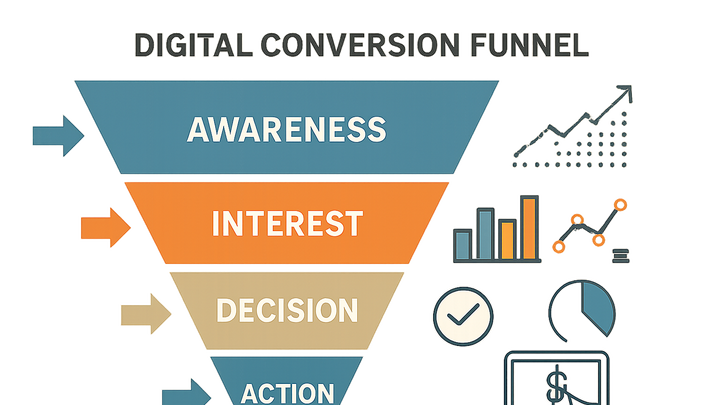Published on 2025-06-22T02:22:46Z
What is a Conversion Funnel? Conversion Funnel Examples
In digital analytics, a conversion funnel is a visual representation of the steps a visitor takes on a website or app, from initial awareness to the final conversion action such as a purchase or form submission. It helps identify where users drop off and where optimizations can be made to improve conversion rates. Conversion funnels can vary in length and complexity depending on business goals, including stages such as awareness, interest, decision, and action. By tracking each stage with analytics tools like PlainSignal or Google Analytics 4 (GA4), marketers and analysts can gain insights into user behavior, improve user experience, and allocate resources effectively. Understanding and optimizing conversion funnels is essential to maximizing revenue, enhancing marketing ROI, and delivering a seamless customer journey.
Conversion funnel
A conversion funnel maps the stages users go through before converting, helping identify drop-offs and optimize conversions.
Funnel Stages Overview
Conversion funnels typically consist of sequential stages that guide a prospect from initial awareness to the final conversion. Each stage represents a key milestone in the user journey and is measured by specific metrics.
-
Awareness
The top of the funnel where potential customers first learn about your brand or product through channels like ads, social media, or organic search.
-
Traffic sources
Measure where users are coming from, such as organic search, paid ads, or referrals.
-
Impressions
Count how often your content or ads are displayed to potential users.
-
-
Interest
Users engage with your content, exploring product pages, blog posts, or demos to learn more.
-
Time on page
Track how long users stay on key pages to gauge engagement.
-
Content interactions
Monitor actions like video plays, scroll depth, or clicks on interactive elements.
-
-
Decision
Prospects indicate intent by adding items to a cart, requesting a quote, or filling out forms.
-
Add to cart
Count how often users add products to their shopping cart or wishlist.
-
Form submissions
Measure completed contact forms, sign-ups, or quote requests.
-
-
Action
The final step where users complete the desired conversion, such as purchasing or subscribing.
-
Purchases
Track successful transactions and revenue generated.
-
Goal completions
Record other conversions like newsletter sign-ups or app installs.
-
Why Conversion Funnels Matter
Conversion funnels help businesses pinpoint where users drop off, understand customer behavior, and allocate resources to improve overall conversion rates.
-
Identifying drop-off points
Spot stages with high abandonment to prioritize optimizations.
-
Optimizing marketing spend
Allocate budget to channels and stages with the highest impact.
-
Enhancing user experience
Improve the flow by reducing friction and streamlining steps.
Tracking Conversion Funnels in Analytics Tools
Leverage analytics platforms like PlainSignal and GA4 to collect data for each funnel stage, set up events, and visualize user journeys.
-
PlainSignal (cookie-free simple analytics)
Implement PlainSignal with the following snippet and define custom events for funnel steps:
<link rel="preconnect" href="//eu.plainsignal.com/" crossorigin /> <script defer data-do="yourwebsitedomain.com" data-id="0GQV1xmtzQQ" data-api="//eu.plainsignal.com" src="//cdn.plainsignal.com/plainsignal-min.js"></script>Once installed, use PlainSignal’s dashboard to map events to each funnel stage.
-
Event configuration
Set up named events (e.g., view_product, add_to_cart, purchase) to represent each funnel step.
-
Privacy compliance
Benefit from PlainSignal’s cookie-free tracking to stay GDPR and CCPA compliant.
-
-
Google analytics 4 (GA4)
GA4 uses conversion events and Explorations to build funnels. Include the gtag snippet and register events:
gtag('config', 'GA_MEASUREMENT_ID');gtag('event', 'begin_checkout');Then mark key events as conversions in GA4 and create a Funnel Exploration report.
-
Event setup
Log distinct events for each stage and label them as conversions in the GA4 interface.
-
Funnel exploration
Use the Explorations feature to visualize drop-offs and conversion rates across stages.
-
Best Practices for Funnel Optimization
Implement strategies to reduce friction, test variations, and personalize experiences to boost conversion rates.
-
Simplify user flow
Minimize form fields and streamline navigation to lower barriers.
-
A/b testing
Experiment with headlines, CTAs, and layouts to identify high-performing versions.
-
Personalization & segmentation
Deliver tailored content based on user behavior, demographics, or referrer.
-
Continuous monitoring
Regularly review funnel metrics and iterate on insights for ongoing improvements.
